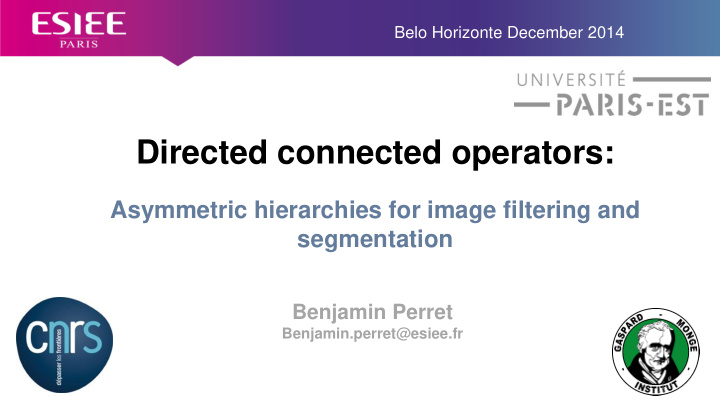



Belo Horizonte December 2014 Directed connected operators: Asymmetric hierarchies for image filtering and segmentation Benjamin Perret Benjamin.perret@esiee.fr 1
Pitch Before After Symmetric adjacency: undirected graph Asymmetric adjacency: directed graph Hierarchical representation: tree Hierarchical representation: acyclic graph B. Perret, J. Cousty, O. Tankyevych, H. Talbot, and N. Passat. Directed connected operators: asymmetric hierarchies for image filtering and segmentation. IEEE TPAMI 2014, DOI: 10.1109/TPAMI.2014.2366145 2
Background Connected image processing A simple paradigm: Only one legal operation : remove connected components Don’t move contours! Efficient algorithms: Mostly linear time & space complexity Versatile framework: Attribute/feature based reasoning Filtering, segmentation, detection, characterization, vision… 3
Background 3D cube filtering : Ouzounis et al, PAMI 2007 Image simplification: Soille, PAMI 3D mesh segmentation: 2008 Cousty et al, PAMI 2010 Interactive segmentation: Degraded document images Passat et al, PR 2010 restoration: Perret et al, TIP 2012 Feature detection : Xu et al. TIP 2014 4
Background Connected image processing General 4 steps procedure 5
Motivations Success of directed adjacency in other frameworks Min-cuts: Boykov et al IJCV 2006 Random Walkers: Singaraju et al CVPR 2008 Shortest path forest: Miranda et al TIP 2014 Pros Handling of naturally directed information : k-nearest neighbor Alleviate the linkage/chaining issue: weak connection Injection of a priori information: expert knowledge, learning Cons Increased complexity… 6
Directed graph Let be a directed graph: is a finite set of points/vertices/nodes is the set of arcs/edges A node/edge weighted graph => a stack of graphs Sequence of nested graphs Level 3 Level 4 Level 0 Level 1 Level 2 Node/edge weighted graph Stack of graphs 7
Directed connected component Let , the Directed connected component (DCC) of base point : The set of successors of denoted Two DCCs may A DCC may contain Asymmetric intersect another DCC behavior of the DCCs 8
Strongly connected component A set is Strongly connected : There is a path from to and from to in A Strongly connected component (SCC) is a strongly connected set of maximal extent The SCC that contains the node is denoted The set of SCCs of a graph forms a partition 9
Stacking DAG The SCCs of a stack of graphs forms a tree Generalization of many known hierarchical representation: component tree, quasi-flat zone hierarchy (MST), watershed hierarchy 10
SCCs and DCCs Relation between DCCs and SCCs Two nodes and are in the same SCC iff they are the base points of the same DCC: The DAG induced by the SCCs: (The SCCs + their adjacency relation) encodes the DCCs DAG of SCCs 11
Stacking DAG The DCCs hierarchy is the combination of The tree of SCCs: encodes the inter-scale relations The DAGs of SCCs: encode the intra-scale relations All the inter/intra scale relations among the DCCs is encoded SCC tree SCC DAGs DCC Hierarchy 12
Algorithm Naive algorithm Number of levels Tarjan algorithm Intra-scale adjacency Inter-scale adjacency Worst case time complexity Suitable for low depth images : 8 bits 13
Application – Retinal image Retinal image segmentation Segmentation and characterization of blood vessels Diagnosis and evolution of several pathologies Detection of the thin and faint vessels High level of background noise Appear as disconnected groups of pixel at low scales Disappear at high scales 14
Application – Retinal image Non local directed adjacency 4 adjacency K-brightest neighbors Allows for: Jumping over noise Weakly connecting noise 15 Adjacency relation at a critical level
Application – Retinal image Filtering criterion A node of the DCC graph is preserved if Very small components are discarded Small components must be elongated Large components must have a « regular » distribution 16
Application – Retinal image Examples 17
Application – Retinal image Evaluation on DRIVE database Non-local directed adjacency with DCC & regularization Non-local directed adjacency with DCC Non-local directed adjacency with SCC Non-local symmetric adjacency 1 Non-local symmetric adjacency 2 Local symmetric adjacency (« better » criterion) State of the art (learning approach) 18
Application – Heart segmentation Supervised segmentation of the myocardium Select the largest DCCs that intersect the object marker but not the background marker Directed gradient with modified weights Indeed equivalent to directed shortest path forest by Miranda et al TIP 2014 19
Application – Neurite filtering Segmentation of neurites in toxicology assays Directed adjacency constructed from a vesselness classification (tube, blob, background) Tubes connect to blobs Background connects to tubes and blobs Filtering rule A tube connect two structures Tubes have thin connections 20 Filtered image Vesselness classification Neurite image
Conclusion Directed component hierarchy Generalization of many known hierarchical image representations Construction algorithm Efficient in most cases More efficient algorithms in preparation (support of 64bits images) Demonstrated on several applications State of the art performance with rather “simple” strategies Python code online ! http://perso.esiee.fr/~perretb/dc-hierarchy.html 21
Recommend
More recommend